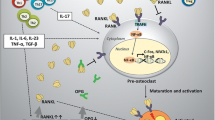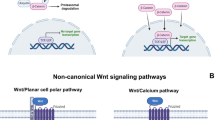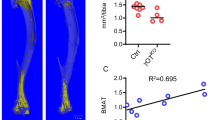Abstract
Consistent with clinical observations demonstrating that hypervitaminosis A is associated with increased skeletal fracture risk, we have previously found that dietary retinol deprivation partially corrects the bone mineralization defects in a mouse model of X-linked hypophosphatemic rickets. That retinol-dependent signaling pathways impact the skeleton is further supported by various findings demonstrating a negative influence of retinoic acid (RA) on bone-forming osteoblasts. We hypothesized that RA would directly regulate the expression of specific target genes in osteoblasts, and we aimed to identify these by genome-wide expression analyses. Here we show that high dietary retinol intake in mice causes low bone mass associated with increased osteoclastogenesis and decreased osteoblastogenesis, but intact bone matrix mineralization. We additionally found that short-term treatment of primary osteoblasts with RA causes a rapid induction of specific genes involved in either retinol-dependent signaling (i.e. Rara, Crabp2) or skeletal remodeling (i.e. Twist2, Tnfsf11). In contrast, neither expression of established osteoblast differentiation markers nor the proliferation rate was immediately affected by RA administration. Collectively, our data suggest that the negative effects of vitamin A on skeletal integrity are explainable by an immediate influence of RA signaling on specific genes in osteoblasts that in turn influence bone remodeling.




Similar content being viewed by others
References
Niederreither K, Dolle P (2008) Retinoic acid in development: towards an integrated view. Nat Rev Genet 9:541–553
Conaway HH, Henning P, Lerner UH (2013) Vitamin A metabolism, action, and role in skeletal homeostasis. Endocr Rev 34:766–797
Chiba M, Teitelbaum SL, Cao X, Ross FP (1996) Retinoic acid stimulates expression of the functional osteoclast integrin alpha v beta 3: transcriptional activation of the beta 3 but not the alpha v gene. J Cell Biochem 62:467–475
Hata K, Kukita T, Akamine A, Kukita A, Kurisu K (1992) Trypsinized osteoclast-like multinucleated cells formed in rat bone marrow cultures efficiently form resorption lacunae on dentine. Bone 13:139–146
Wang X, Wu J, Shidoji Y, Muto Y, Ohishi N, Yagi K, Ikegami S, Shinki T, Udagawa N, Suda T, Ishimi Y (2002) Effects of geranylgeranoic acid in bone: induction of osteoblast differentiation and inhibition of osteoclast formation. J Bone Miner Res 17:91–100
Conaway HH, Persson E, Halen M, Granholm S, Svensson O, Pettersson U, Lie A, Lerner UH (2009) Retinoids inhibit differentiation of hematopoietic osteoclast progenitors. FASEB J 23:3526–3538
Kneissel M, Studer A, Cortesi R, Susa M (2005) Retinoid-induced bone thinning is caused by subperiosteal osteoclast activity in adult rodents. Bone 36:202–214
Hu L, Lind T, Sundqvist A, Jacobson A, Melhus H (2010) Retinoic acid increases proliferation of human osteoclast progenitors and inhibits RANKL-stimulated osteoclast differentiation by suppressing RANK. PLoS One 5:e13305
Park CK, Ishimi Y, Ohmura M, Yamaguchi M, Ikegami S (1997) Vitamin A and carotenoids stimulate differentiation of mouse osteoblastic cells. J Nutr Sci Vitaminol (Tokyo) 43:281–296
Ohishi K, Nishikawa S, Nagata T, Yamauchi N, Shinohara H, Kido J, Ishida H (1995) Physiological concentrations of retinoic acid suppress the osteoblastic differentiation of fetal rat calvaria cells in vitro. Eur J Endocrinol 133:335–341
Yan T, Wergedal J, Zhou Y, Mohan S, Baylink DJ, Strong DD (2001) Inhibition of human osteoblast marker gene expression by retinoids is mediated in part by insulin-like growth factor binding protein-6. Growth Horm IGF Res 11:368–377
Cohen-Tanugi A, Forest N (1998) Retinoic acid suppresses the osteogenic differentiation capacity of murine osteoblast-like 3/A/1D-1 M cell cultures. Differentiation 63:115–123
Hong SH, Mochizuki M, Nishimura R, Sasaki N, Kadosawa T, Matsunaga S (2000) Differentiation induction of canine osteosarcoma cell lines by retinoids. Res Vet Sci 68:57–62
Michaelsson K, Lithell H, Vessby B, Melhus H (2003) Serum retinol levels and the risk of fracture. N Engl J Med 348:287–294
Feskanich D, Singh V, Willett WC, Colditz GA (2002) Vitamin A intake and hip fractures among postmenopausal women. JAMA 287:47–54
Promislow JH, Goodman-Gruen D, Slymen DJ, Barrett-Connor E (2002) Retinol intake and bone mineral density in the elderly: the Rancho Bernardo Study. J Bone Miner Res 17:1349–1358
Wolf RL, Cauley JA, Pettinger M, Jackson R, Lacroix A, Leboff MS, Lewis CE, Nevitt MC, Simon JA, Stone KL, Wactawski-Wende J (2005) Lack of a relation between vitamin and mineral antioxidants and bone mineral density: results from the Women’s Health Initiative. Am J Clin Nutr 82:581–588
Rejnmark L, Vestergaard P, Charles P, Hermann AP, Brot C, Eiken P, Mosekilde L (2004) No effect of vitamin A intake on bone mineral density and fracture risk in perimenopausal women. Osteoporos Int 15:872–880
Ballew C, Galuska D, Gillespie C (2001) High serum retinyl esters are not associated with reduced bone mineral density in the Third National Health And Nutrition Examination Survey, 1988–1994. J Bone Miner Res 16:2306–2312
Bastien J, Rochette-Egly C (2004) Nuclear retinoid receptors and the transcription of retinoid-target genes. Gene 328:1–16
Kawaguchi R, Yu J, Honda J, Hu J, Whitelegge J, Ping P, Wiita P, Bok D, Sun H (2007) A membrane receptor for retinol binding protein mediates cellular uptake of vitamin A. Science 315:820–825
Molotkov A, Fan X, Deltour L, Foglio MH, Martras S, Farres J, Pares X, Duester G (2002) Stimulation of retinoic acid production and growth by ubiquitously expressed alcohol dehydrogenase Adh3. Proc Natl Acad Sci USA 99:5337–5342
Sandell LL, Sanderson BW, Moiseyev G, Johnson T, Mushegian A, Young K, Rey JP, Ma JX, Staehling-Hampton K, Trainor PA (2007) RDH10 is essential for synthesis of embryonic retinoic acid and is required for limb, craniofacial, and organ development. Genes Dev 21:1113–1124
Dupe V, Matt N, Garnier JM, Chambon P, Mark M, Ghyselinck NB (2003) A newborn lethal defect due to inactivation of retinaldehyde dehydrogenase type 3 is prevented by maternal retinoic acid treatment. Proc Natl Acad Sci USA 100:14036–14041
Piletta P, Saurat JH (1993) Cellular retinoic acid-binding proteins (CRABP). Exp Dermatol 2:191–195
Germain P, Chambon P, Eichele G, Evans RM, Lazar MA, Leid M, De Lera AR, Lotan R, Mangelsdorf DJ, Gronemeyer H (2006) International Union of Pharmacology. LX. Retinoic acid receptors. Pharmacol Rev 58:712–725
Germain P, Chambon P, Eichele G, Evans RM, Lazar MA, Leid M, De Lera AR, Lotan R, Mangelsdorf DJ, Gronemeyer H (2006) International Union of Pharmacology. LXIII. Retinoid X receptors. Pharmacol Rev 58:760–772
White JA, Beckett-Jones B, Guo YD, Dilworth FJ, Bonasoro J, Jones G, Petkovich M (1997) cDNA cloning of human retinoic acid-metabolizing enzyme (hP450RAI) identifies a novel family of cytochromes P450. J Biol Chem 272:18538–18541
Marikar Y, Wang Z, Duell EA, Petkovich M, Voorhees JJ, Fisher GJ (1998) Retinoic acid receptors regulate expression of retinoic acid 4-hydroxylase that specifically inactivates all-trans retinoic acid in human keratinocyte HaCaT cells. J Invest Dermatol 111:434–439
Sonneveld E, van den Brink CE, van der Leede BM, Schulkes RK, Petkovich M, van der Burg B, van der Saag PT (1998) Human retinoic acid (RA) 4-hydroxylase (CYP26) is highly specific for all-trans-RA and can be induced through RA receptors in human breast and colon carcinoma cells. Cell Growth Differ 9:629–637
Sonneveld E, van den Brink CE, Tertoolen LG, van der Burg B, van der Saag PT (1999) Retinoic acid hydroxylase (CYP26) is a key enzyme in neuronal differentiation of embryonal carcinoma cells. Dev Biol 213:390–404
Schinke T, Gebauer M, Schilling AF, Lamprianou S, Priemel M, Mueldner C, Neunaber C, Streichert T, Ignatius A, Harroch S, Amling M (2008) The protein tyrosine phosphatase Rptpzeta is expressed in differentiated osteoblasts and affects bone formation in mice. Bone 42:524–534
Seitz S, Rendenbach C, Barvencik F, Streichert T, Jeschke A, Schulze J, Amling M, Schinke T (2013) Retinol deprivation partially rescues the skeletal mineralization defects of Phex-deficient Hyp mice. Bone 53:231–238
Albers J, Keller J, Baranowsky A, Beil FT, Catala-Lehnen P, Schulze J, Amling M, Schinke T (2013) Canonical Wnt signaling inhibits osteoclastogenesis independent of osteoprotegerin. J Cell Biol 200:537–549
Parfitt AM, Drezner MK, Glorieux FH, Kanis JA, Malluche H, Meunier PJ, Ott SM, Recker RR (1987) Bone histomorphometry: standardization of nomenclature, symbols, and units. Report of the ASBMR Histomorphometry Nomenclature Committee. J Bone Miner Res 2:595–610
Rendenbach C, Yorgan TA, Heckt T, Otto B, Baldauf C, Jeschke A, Streichert T, David JP, Amling M, Schinke T (2014) Effects of extracellular phosphate on gene expression in murine osteoblasts. Calcif Tissue Int 94:474–483
Trechsel U, Stutzer A, Fleisch H (1987) Hypercalcemia induced with an arotinoid in thyroparathyroidectomized rats. New model to study bone resorption in vivo. J Clin Invest 80:1679–1686
Hough S, Avioli LV, Muir H, Gelderblom D, Jenkins G, Kurasi H, Slatopolsky E, Bergfeld MA, Teitelbaum SL (1988) Effects of hypervitaminosis A on the bone and mineral metabolism of the rat. Endocrinology 122:2933–2939
Lind T, Lind PM, Jacobson A, Hu L, Sundqvist A, Risteli J, Yebra-Rodriguez A, Larsson S, Rodriguez-Navarro A, Andersson G, Melhus H (2011) High dietary intake of retinol leads to bone marrow hypoxia and diaphyseal endosteal mineralization in rats. Bone 48:496–506
Raisz LG (1965) Bone resorption in tissue culture. Factors influencing the response to parathyroid hormone. J Clin Invest 44:103–116
Togari A, Kondo M, Arai M, Matsumoto S (1991) Effects of retinoic acid on bone formation and resorption in cultured mouse calvaria. Gen Pharmacol 22:287–292
Conaway HH, Grigorie D, Lerner UH (1997) Differential effects of glucocorticoids on bone resorption in neonatal mouse calvariae stimulated by peptide and steroid-like hormones. J Endocrinol 155:513–521
Conaway HH, Pirhayati A, Persson E, Pettersson U, Svensson O, Lindholm C, Henning P, Tuckermann J, Lerner UH (2011) Retinoids stimulate periosteal bone resorption by enhancing the protein RANKL, a response inhibited by monomeric glucocorticoid receptor. J Biol Chem 286:31425–31436
Scheven BA, Hamilton NJ (1990) Retinoic acid and 1,25-dihydroxyvitamin D3 stimulate osteoclast formation by different mechanisms. Bone 11:53–59
Xiong J, Onal M, Jilka RL, Weinstein RS, Manolagas SC, O’Brien CA (2011) Matrix-embedded cells control osteoclast formation. Nat Med 17:1235–1241
Nakashima T, Hayashi M, Fukunaga T, Kurata K, Oh-Hora M, Feng JQ, Bonewald LF, Kodama T, Wutz A, Wagner EF, Penninger JM, Takayanagi H (2011) Evidence for osteocyte regulation of bone homeostasis through RANKL expression. Nat Med 17:1231–1234
Suda T, Takahashi N, Udagawa N, Jimi E, Gillespie MT, Martin TJ (1999) Modulation of osteoclast differentiation and function by the new members of the tumor necrosis factor receptor and ligand families. Endocr Rev 20:345–357
Lind T, Sundqvist A, Hu L, Pejler G, Andersson G, Jacobson A, Melhus H (2013) Vitamin A is a negative regulator of osteoblast mineralization. PLoS One 8:e82388
Hisada K, Hata K, Ichida F, Matsubara T, Orimo H, Nakano T, Yatani H, Nishimura R, Yoneda T (2013) Retinoic acid regulates commitment of undifferentiated mesenchymal stem cells into osteoblasts and adipocytes. J Bone Miner Metab 31:53–63
Cummings SR, San Martin J, McClung MR, Siris ES, Eastell R, Reid IR, Delmas P, Zoog HB, Austin M, Wang A, Kutilek S, Adami S, Zanchetta J, Libanati C, Siddhanti S, Christiansen C (2009) Denosumab for prevention of fractures in postmenopausal women with osteoporosis. N Engl J Med 361:756–765
Smith MR, Egerdie B, Hernandez Toriz N, Feldman R, Tammela TL, Saad F, Heracek J, Szwedowski M, Ke C, Kupic A, Leder BZ, Goessl C (2009) Denosumab in men receiving androgen-deprivation therapy for prostate cancer. N Engl J Med 361:745–755
Bialek P, Kern B, Yang X, Schrock M, Sosic D, Hong N, Wu H, Yu K, Ornitz DM, Olson EN, Justice MJ, Karsenty G (2004) A twist code determines the onset of osteoblast differentiation. Dev Cell 6:423–435
Miraoui H, Marie PJ (2010) Pivotal role of Twist in skeletal biology and pathology. Gene 468:1–7
Fulzele K, Riddle RC, DiGirolamo DJ, Cao X, Wan C, Chen D, Faugere MC, Aja S, Hussain MA, Bruning JC, Clemens TL (2010) Insulin receptor signaling in osteoblasts regulates postnatal bone acquisition and body composition. Cell 142:309–319
Acknowledgments
This work was supported by the German Federal Ministry of Education and Research within the framework of the project “Molecular Pathology of Osteoporosis” (OsteoPath).
Conflict of interest
All authors have no conflicts of interest.
Author information
Authors and Affiliations
Corresponding author
Additional information
T. Yorgan, T. Heckt and C. Rendenbach contributed equally to this work.
Electronic supplementary material
Below is the link to the electronic supplementary material.
774_2015_666_MOESM1_ESM.pdf
Supplementary material 1 (PDF 17 kb) Supplementary Table 1. ATRA-induced genes in primary osteoblasts. The results of genome-wide expression analysis in primary osteoblasts following treatment with ATRA for 6 h are shown. The signal intensities and the logarithmic ratios of signal intensities (signal log ratio, SLR) are given. The table includes all genes with a signal intensity >100 and an SLR >2.0
About this article
Cite this article
Yorgan, T.A., Heckt, T., Rendenbach, C. et al. Immediate effects of retinoic acid on gene expression in primary murine osteoblasts. J Bone Miner Metab 34, 161–170 (2016). https://doi.org/10.1007/s00774-015-0666-2
Received:
Accepted:
Published:
Issue Date:
DOI: https://doi.org/10.1007/s00774-015-0666-2




